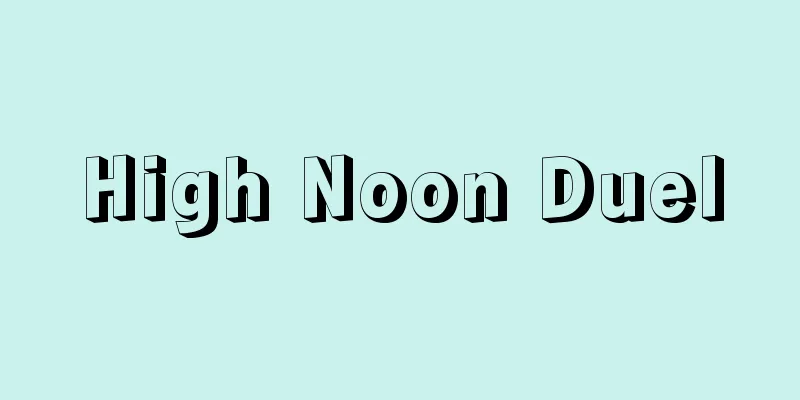Extra - Gargle

|
This refers to an edition that is issued extra in addition to the regular editions that a newspaper company issues on a regular basis. In other countries, it is called an extra. In general, it often refers to a breaking news edition of a major incident or sudden news. Therefore, until radio waves began to demonstrate their breaking news capabilities, it took the news world by storm as the only way to break news. Its origins are ancient, and in the United States, there are records of newspapers issuing extra editions in the early 18th century in Boston, where the first weekly newspapers appeared. In Japan, the first extra edition was the May 16, 1868 edition of the "Bekdan Chugai Shimbun," which reported on the Ueno Shogitai Incident, and the words "betsudan," "betsugo," and "betsushi" were used to mean "extra edition" at the time. However, in the early days, news that came in after the deadline was sometimes inserted as an appendix into the main paper or attached to the main paper as a sticky note, but the essence of an extra edition was that it did not follow the issue and was delivered separately as breaking news. In this sense, the Tokyo Nichi Nichi Shimbun Supplement dated March 2, 1876 (Meiji 9) (announcement of the signing of the Treaty of Ganghwa), the Yomiuri Shimbun Supplement dated March 6th (announcement of the return of Kuroda Kiyotaka and Inoue Kaoru to Tokyo from Korea), and the Yomiuri Shimbun Supplement and Choya Shimbun dated October 29th of the same year, which reported on the Kumamoto Shinpuren Rebellion, can be considered essential extra editions. All newspapers issued extra editions during the Seinan War in 1877, but it was not until the 1990s, when newspapers began to compete to publish the latest news, that the battle for extra editions became more active. The pioneering example was the reporting of the promulgation of the Constitution of the Empire of Japan on February 11th, 1889. At that time, the Tokyo Nichi Nichi Shimbun in Tokyo and the Osaka Asahi Shimbun in Osaka surprised other newspapers by publishing the full text of the constitution in an extra edition. It wasn't until the Sino-Japanese War (1894-95) that extra editions became popular and newspapers began to compete with each other on the extra edition market, when a new business called "extra edition sales" first appeared in Tokyo. During the Russo-Japanese War (1904-05), Osaka-based newspapers Asahi and Mainichi engaged in a fierce battle to publish extra editions, and even prepared extra editions in anticipation of the fall of Port Arthur in China and the peace conference, competing to provide the latest news. In the Showa era, however, the first report of the Manchurian Incident (1931) was broadcast as a special news segment on the radio. After this, radio listenership increased dramatically, and newspapers began to publish large-format extra editions to compete with this trend. However, during World War II, press censorship and a shortage of paper meant that the publication of extra editions was less frequent than before. After the war, with the spread of broadcasting, extra editions almost disappeared, but on major events such as the assassination of President Kennedy in the United States (1963) and the arrest of Kakuei Tanaka in the Lockheed Scandal (1976), extra editions were still distributed in entertainment districts such as around local publishers and at major stations in Tokyo and Osaka. Before the war, extra editions were sold for a fee in Tokyo, but they were free in Osaka, and after the war they have been distributed free of charge in both cases. [Akihiko Sunohara] "Hideo Ono (ed.) 'Extra Newspapers: A Hundred Year History' (1969, Yomiuri Shimbun)" Source: Shogakukan Encyclopedia Nipponica About Encyclopedia Nipponica Information | Legend |
|
新聞社が定期的に継続して発行する通常号以外に臨時に発行する版をいう。外国ではエキストラextraとよんでいる。一般的には大事件、突発ニュースの速報版をさすことが多い。したがって、電波メディアが速報性を発揮するようになるまでは、唯一の速報手段として報道界を風靡(ふうび)した。その起源は古く、アメリカでは18世紀初め、最初に週刊紙が現れたボストンの各新聞社が号外を出したという記録がある。 日本では1868年(慶応4)5月16日付けの上野彰義隊(しょうぎたい)事件を報道した『別段中外新聞』が最初の号外といわれ、当時は別段、別号、別紙ということばを号外の意味に使っている。ただ初期のころは、締切り後に入ったニュースを、付録として本紙に挟み込んだり、本紙に付箋(ふせん)したものもあるが、号外の本質はあくまでも号を追わないことと、速報のため別配達したものである。1876年(明治9)3月2日付けの『東京日日新聞付録』(江華(こうか)条約締結)、同月6日付けの『読売新聞別紙』(黒田清隆(きよたか)、井上馨(かおる)全権の朝鮮からの帰京)、同年10月29日付けの熊本神風連(しんぷうれん)の乱などを報ずる『読売新聞付録』『朝野(ちょうや)新聞』などはその意味で本質的号外といえる。77年の西南戦争には各社とも号外を出しているが、号外合戦が盛んになるのは、新聞の速報競争が激しくなる90年代以降で、その先駆けをなしたのが、89年2月11日の大日本帝国憲法発布の報道だった。このとき東京では『東京日日新聞』、大阪では『大阪朝日新聞』が憲法全文を号外で速報、他紙を驚かせた。 本格的な号外が盛んになり、各社が号外でしのぎを削るようになるのは日清(にっしん)戦争(1894~95)からで、このとき初めて東京で「号外売り」という新商売が現れている。日露戦争(1904~05)のときは、大阪の『朝日』『毎日』が激しい号外合戦を展開、中国の旅順陥落や講和会議のときには予想号外まで準備して速報を競ったが、昭和に入ると、満州事変(1931)の第一報はラジオの臨時ニュースで放送されることになった。以後、ラジオの聴取者が激増し、新聞はこれに対抗するため、大型写真号外を発行するようになった。しかし第二次世界大戦中は、報道管制と用紙の欠乏から、号外の発行は以前よりも低調だった。戦後は、放送の普及もあって号外はほとんど影を潜めたが、それでもアメリカのケネディ大統領暗殺(1963)、ロッキード事件の田中角栄逮捕(1976)など大事件の際には、地方発行社の周辺、東京、大阪の主要駅など盛り場で号外を配布することがある。なお、戦前、東京では号外は有料だったが、大阪では無料、戦後はいずれも無料で号外を配っている。 [春原昭彦] 『小野秀雄編『号外百年史』(1969・読売新聞社)』 出典 小学館 日本大百科全書(ニッポニカ)日本大百科全書(ニッポニカ)について 情報 | 凡例 |
Recommend
KS magnet steel
The name of a permanent magnet discovered in 1916...
Dusky thrush
A passerine bird of the family Muscicapidae and su...
obshchina
…Russian rural communities, also called obshchina...
Albacore (long-legged) - Albacore (English spelling)
A marine fish of the Scombridae family in the orde...
Iraga (stinging moth) - Iraga
A general term for insects belonging to the Lepido...
Torajiro Tsukamoto - Torajiro Tsukamoto
A non-church Christian evangelist. Born in Fukuok...
Fêtes galantes (France)
The word means "an erotic banquet," but ...
Orchestration - Kangengakuho
...In the 19th century, Weber, Berlioz, and Meyer...
mace head
…Other stone axes used as weapons or ceremonial g...
Aitōlia (English spelling)
The area was located in the north shore of the Gul...
Prunus leveilleana (English spelling) Prunusleveilleana
…[Hiroshi Aramata]. … *Some of the terminology th...
Okinaga clan
An ancient clan based in Okinaga, Sakata County, O...
Olivine sand
...It accounts for the majority of foundry sand. ...
Owada - Owada
…Under the Ritsuryo system, the Sanyo Road, a lan...
Preceptor - Sendatsu
〘noun〙① To be the first to reach a certain path in...









